Why the Marine Corps Memorial Features Men Who Weren’t in the Famous Photograph
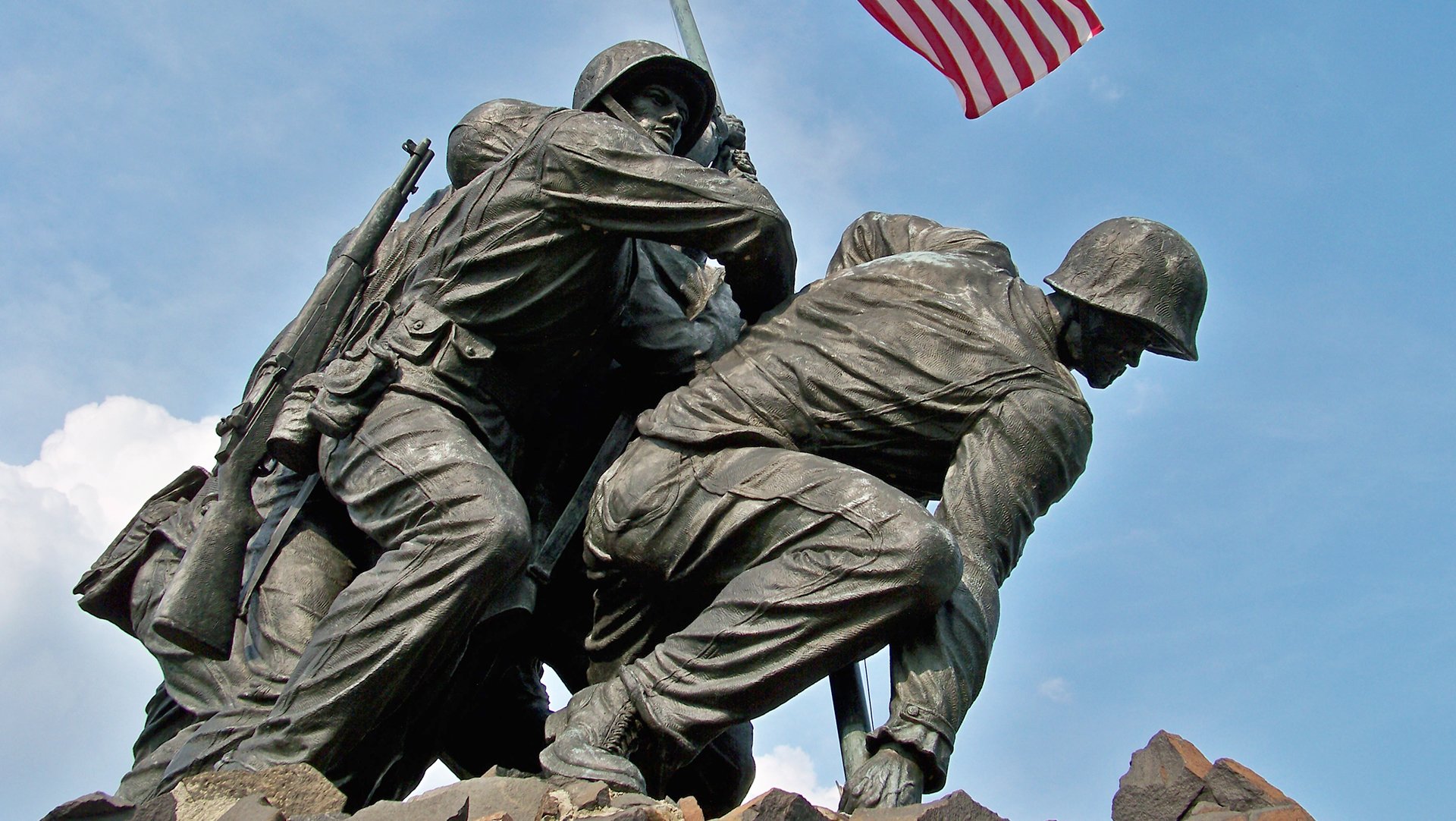
The Marine Corps War Memorial sits on the northern tip of Arlington National Cemetery, and features several men who didn't participate in the iconic flag-raising. Wikimedia Commons photo.
Standing nearly 80 feet tall, the six American GIs remain frozen in time, forever raising the Stars and Stripes that fly 24 hours a day, 365 days a year, over Arlington, Virginia.
Modeled after Joe Rosenthal’s famous photograph of Marines raising the American flag atop Iwo Jima’s Mount Suribachi on the morning of Feb. 23, 1945, the concrete, granite, and bronze monument is a testament to the indomitable fighting spirit of the United States Marine Corps.
However, while the act of raising the flag over Iwo Jima is immortalized by Felix de Weldon’s statue, not all of the men who appeared in Rosenthal’s photograph are represented in the monument. In fact, Weldon modeled two of the figures after Marines who weren’t actually there.
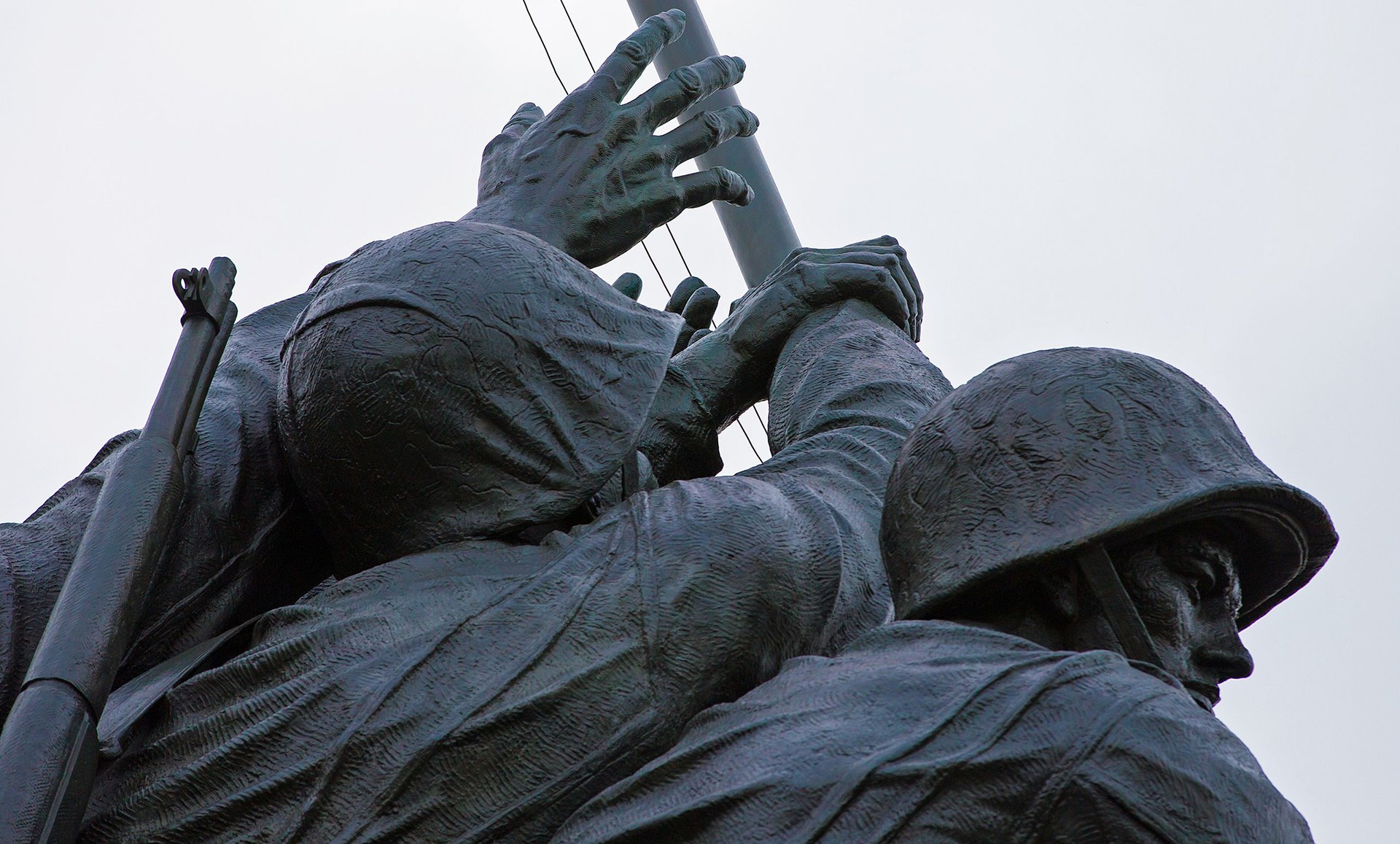
The memorial, completed in 1954, remains the largest bronze statue in the world. Photo courtesy of Wikimedia Commons.
In 1954, on the 179th Marine Corps birthday, President Dwight D. Eisenhower officially dedicated the Marine Corps War Memorial before a small crowd of World War II veterans. The 700-ton base is surrounded by polished Bonaccord granite embossed with an inscription listing every major Marine Corps engagement since the branch’s founding in 1775. A golden ring encircles the monument, which also bears Adm. Charles “Chester” Nimitz’s famous quote about the brave Americans who fought in Iwo Jima in the spring of 1945: “Uncommon valor was a common virtue.”
Carrying 16-foot M1 Garands, 12-foot M1 carbines, and Kabar knives 5 1/2 feet long, five of the six figures — each 32 feet tall and clutching the iconic 60-foot flagpole — are modeled after the troops initially believed to be the men in Rosenthal’s photograph. The six first thought to have been captured on film were Sgt. Michael Strank, Sgt. Hank Hansen, Hospital Corpsman James Bradley, Cpl. Ira Hayes, Pfc. Franklin Sousley, and Pfc. Rene Gagnon.
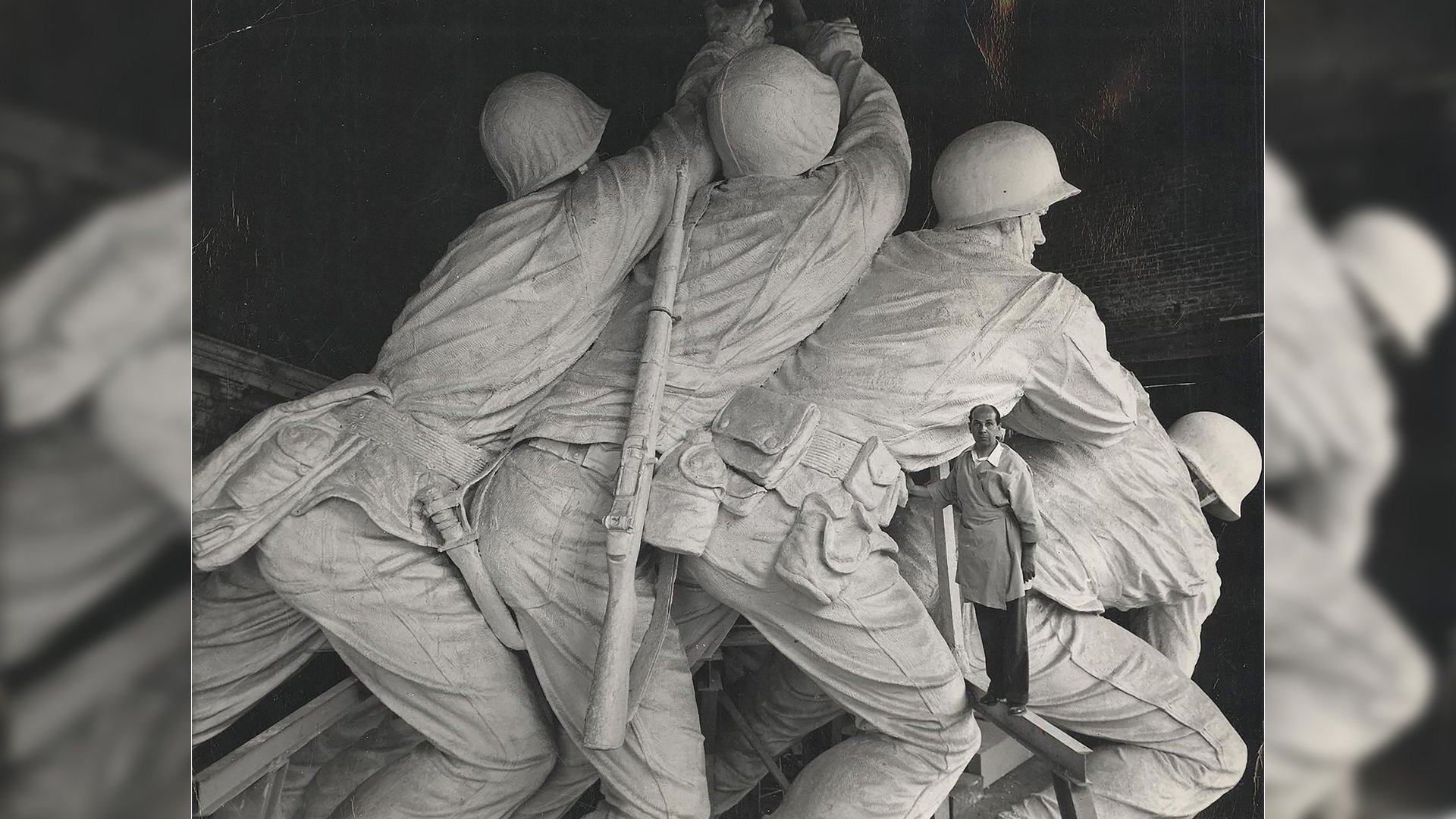
Mr. Felix W. de Weldon, sculptor of the famous Marine Corps Memorial, is shown putting finishing touches on the plaster model, prior to its being sent out in sections for bronze casting. Photo courtesy of Wikimedia Commons.
Two years after the battle, the Marine Corps announced that the Marine who appears in Rosenthal's photograph at the base of the flagpole was Cpl. Harlon Block, not Hansen. Hansen had taken part in raising the first, smaller flag earlier in the day.
Only long after the monument was completed did people start to question whether two of the other men had been misidentified. In 2016, about six decades after the monument was cast in bronze, an investigation revealed that Bradley was not in the photograph, either. The man thought to be Bradley was actually Cpl. Harold Schultz. (In the photo, Schultz is standing directly behind Block.)
Furthermore, a second investigation, conducted in 2019, concluded that Gagnon — though he had carried the second and larger flag up the volcano that day — had also been misidentified in the photograph. The man long believed to be Gagnon was in fact Cpl. Harold Keller.
When de Weldon began sculpting the bronze giants in 1947, he relied on photographs to sculpt Strank, Block, and Sousley (all of whom, as well as Hansen, were killed in action before the battle was over), but he had the men whom he believed to be the three survivors pose for him. Those were Hayes, Bradley, and Gagnon.
Thus, the largest bronze statue in the world, according to the Marine Corps, is not a true representation of the event it was erected to memorialize.
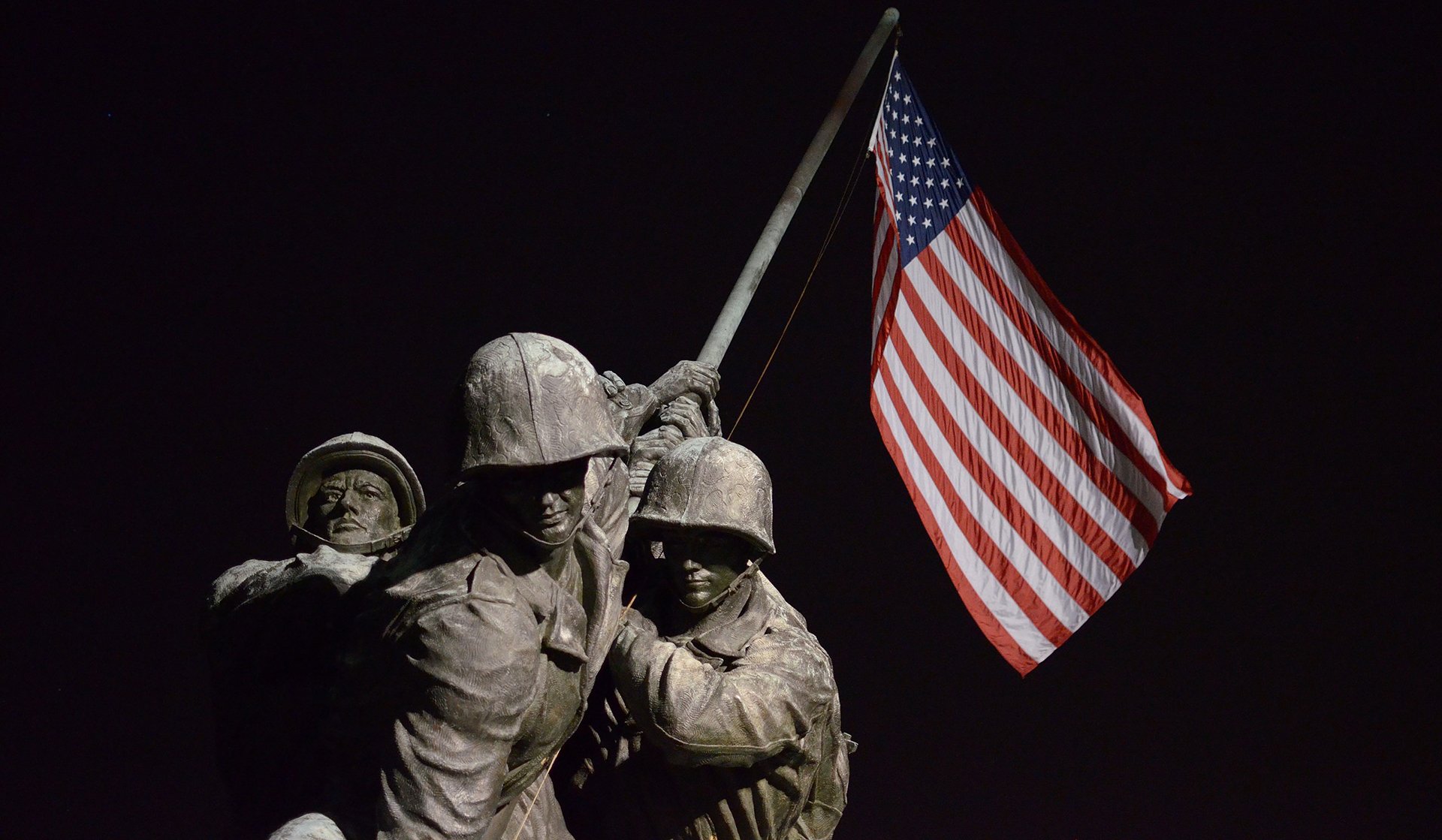
Sculptures of Bradley (left), Block (center), and Gagnon (right) are shown hoisting the flag, though neither Bradley nor Gagnon were actually in Rosenthal's iconic photograph. Photo courtesy of Wikimedia Commons.
Does it matter? Perhaps to some. However, there are also those who would argue that it doesn’t, and they will be quick to note that, despite the misidentification of Schultz and Keller as Bradley and Gagnon, the memorial is still ultimately a tribute to the Marine Corps, not just the individual Marines who heroically raised the flag over Iwo Jima that day.
“To the Marines, it’s not about the individuals and never has been,” Gen. Robert Neller, the 37th commandant of the Marine Corps, said in a 2016 statement. “Simply stated, our fighting spirit is captured in that frame, and it remains a symbol of the tremendous accomplishments of our Corps — what they did together and what they represent remains most important. That doesn’t change.”
Read Next: Salty Dogs: The Long and Proud Tradition of Tattoos in the Marine Corps
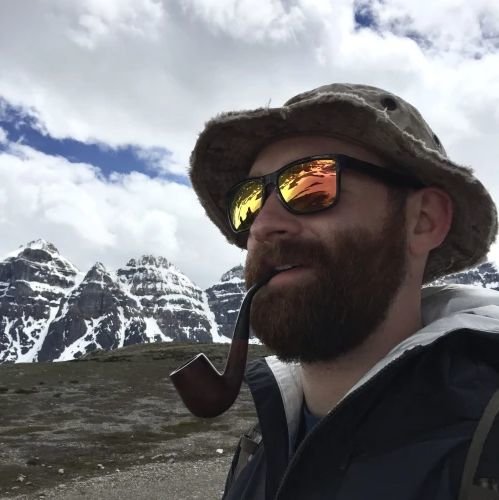
Mac Caltrider is a senior staff writer for Coffee or Die Magazine. He served in the US Marine Corps and is a former police officer. Caltrider earned his bachelor’s degree in history and now reads anything he can get his hands on. He is also the creator of Pipes & Pages, a site intended to increase readership among enlisted troops. Caltrider spends most of his time reading, writing, and waging a one-man war against premature hair loss.
BRCC and Bad Moon Print Press team up for an exclusive, limited-edition T-shirt design!
BRCC partners with Team Room Design for an exclusive T-shirt release!
Thirty Seconds Out has partnered with BRCC for an exclusive shirt design invoking the God of Winter.
Lucas O'Hara of Grizzly Forge has teamed up with BRCC for a badass, exclusive Shirt Club T-shirt design featuring his most popular knife and tiomahawk.
Coffee or Die sits down with one of the graphic designers behind Black Rifle Coffee's signature look and vibe.
Biden will award the Medal of Honor to a Vietnam War Army helicopter pilot who risked his life to save a reconnaissance team from almost certain death.
Ever wonder how much Jack Mandaville would f*ck sh*t up if he went back in time? The American Revolution didn't even see him coming.
A nearly 200-year-old West Point time capsule that at first appeared to yield little more than dust contains hidden treasure, the US Military Academy said.












